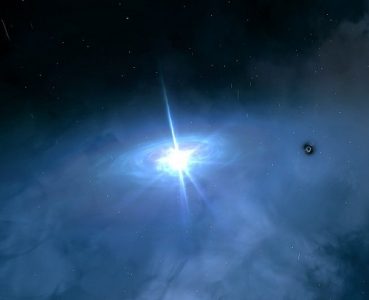In New Eden there are many who make their ISK by dwelling in the furthest and arguably most inhospitable parts of space. In New Eden we know of this space by many different names, some call it “W-Space”, “Wormholes” or “Anoikis”. Within these secret depths of space there resides the most fickle god of all, Bob, and hordes of menacing sleepers. To top this all off, the space is typically affected by one of a number of beautiful yet destructive spatial anomalies. One of the more popular wormhole environments is the Pulsar, and in EVE this causes an increase in Shield Hitpoints, Signature Radius, and Energy Neutralizer drain amount, while reducing the armor resistances and capacitor recharge rates. It cannot go without saying that while the Pulsar environmental effects are good for ratting, it can cause problems of its own.

In the real world however, Pulsars, or Pulsating Radio Stars are highly magnetized, rotating neutron stars that emit beams of electromagnetic radiation. However, this radiation can only be seen when pointing directly at the Earth. Due to a neutron star’s extreme density and short rotational period, they act as interstellar lighthouses as the beams pulse towards the Earth at short and constant intervals. Some Pulsars even rival atomic clocks in their accuracy.
The precise location and pulse from Pulsars often make them useful tools for astronomical observation. Observations of a pulsar binary system were used to confirm the existence of gravitational radiation, and the first exoplanets were discovered in orbit of the pulsar PSR B1257+12. Voyager One, our planet’s first extra-solar spacecraft even has a sort of map depicting Earth’s location via pulsars.
NASA’s Chandra X-Ray Observatory, their flagship X-Ray telescope, recently viewed an interesting event in the system of PSR B1259-63/LS 2883 (B1259 for short). B1259 contains two stars, an active star that is about thirty times as massive as the sun, and a pulsar, the remnant of an even more massive twin who underwent a supernova explosion.

B1259’s pulsar emits regular pulses as it spins on its axis twenty times per second. However, the pulsar also orbit’s its companion in a highly elliptical orbit. The rapid rotation and powerful magnetic field of the pulsar generates strong stellar winds, consisting of high-energy particles moving near the speed of light. B1259’s companion star is rotating at near break-up speeds, where the centrifugal force at the equator overcomes the force of gravity. Because of this rapid rotation, B1259’s companion has slung a disk of gaseous material into orbit. When the pulsar makes its closest approach to the companion star, every forty-one months, it passes through this disk.
B1259’s pulsar likes to don the position of the older brother and essentially “punched a clump of material out and flung it away into space” according to George Pavlov of Penn State University. Oleg Kargaltsev of George Washington University adds that, “After this clump of stellar material was knocked out, the pulsar’s wind appears to have accelerated it, almost as if it had a rocket attached.” Between December of 2011, and February of 2014, Chandra observed B1259 three times. These observations show the stellar clump moving away at an average speed of 7% light, though data also indicates that the clump has been accelerated to 15% light between the second and third observations.
Jeremy Hare of George Washington University explains the importance of the observation, “This just shows how powerful the wind blasting off a pulsar can be, the pulsar’s wind is so strong that it could ultimately eviscerate the entire disk around its companion star over time.”
Chandra originally observed an X-Ray emission produced by the shock wave as B1259’s pulsar’s wind rammed into the disk. The ram pressure generated by this interaction is also likely to have accelerated the clump to its current velocities. Chandra will continue to monitor B1259 and its moving clump with scheduled observations later this year, and into 2016.
This article originally appeared on TheMittani.com, written by Kristoff Merkas.

